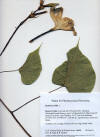|
 
Ipomoea alba
HI: Oahu
Spjut & Marin 15639, Oct 2003
Species with
antitumor activity
Ipomoea cissoides
Ipomoea stolonifera |

Ipomoea indica
CA: Cultivated—Bakersfield, Spjut 16034, Sep 2006. Sold under the name of Ipomoea
acuminata, which is treated as a synonym of I. indica (see
Austin and Huaman in Taxon 45: 3-38, 1996). This is a perennial
species similar to I. tricolor, which is known for its
hallucinogenic seeds; however, the cultivar shown above (I. indica)
does not seem to produce seed in cultivation (which suggests it may be a
hybrid derivative); it is, nevertheless, aggressive in spreading and
rooting, and upon prolonged contact with the plant, one may get a minor
rash. Hortus Third (Liberty Hyde Bailey Hortorium 1976) describes
this species (under the synonym I. acuminata) to have relatively
large flowers (up to 5 inches long), in contrast to smaller flowers in
related species such as I. hederacea and I. nil (flowers up
to 2 inches long) that also differ by their annual growth.
Identification is further based on a taxonomic key in Henri Alain Liogier,
Descriptive Flora of Puerto Rico
and Adjacent Islands Vol. IV (1995). Ipomoea indica is
distinguished by the greenish long tapered sepals. Ipomoea
tricolor differs in having a white scarious margined sepals, while
another related species, I. purpurea, is distinguished by the
colored band on each of its petals and also by its annual growth.
Ipelearoside, active
in WA, was reportedly isolated by Dhar from a sample of this species
(Hartwell 1976). |
|
Cao S., R. C.
Guza, J. H. Wisse, J. S. Miller, R. Evans and D. G. Kingston. 2005.
Ipomoeassins A-E, cytotoxic macrocyclic glycoresins from the leaves of
Ipomoea squamosa from the Suriname rainforest. J. Nat. Prod. 68:
487–492.
“The new glycoresins, ipomoeassins A-E (1-5), have been
isolated from the leaves of Ipomoea squamosa. The structures were
elucidated by spectroscopic analyses and chemical transformations. The
absolute configurations of C-5 (ipomoeassins 3-5) and C-11 (ipomoeassins 1
and 2) were determined by their derivatives with (R)- and (S)-MPA. All the
isolates were active in the A2780 human ovarian cancer cell line assay,
and 4 showed the highest activity with an IC(50) value of 35 nM.”
|


